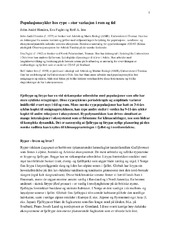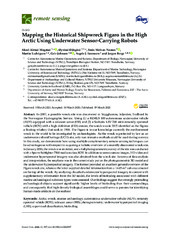Institutt for arktisk og marin biologi: Recent submissions
Now showing items 1101-1120 of 2084
-
Populasjonssykluser hos rype – stor variasjon i rom og tid
(Journal article; Tidsskriftartikkel; Peer reviewed, 2019-06-27)Fjellrype og lirype har en vid sirkumpolar utbredelse, med populasjoner som ofte har store, sykliske svingninger. Disse rypesyklusenes periodelengde og amplitude varierer imidlertid svært mye i tid og rom. Mens norske rypepopulasjoner har hatt en 3–4-års syklus koplet til smågnagersyklusen, kan rype andre steder i verden ha 9–11-års sykluser koplet til andre arter i økosystemet. Rypedynamikken kan ... -
Quantifying tourism booms and the increasing footprint in the Arctic with social media data
(Journal article; Tidsskriftartikkel; Peer reviewed, 2020-01-16)Arctic tourism has rapidly increased in the past two decades. We used social media data to examine localized tourism booms and quantify the spatial expansion of the Arctic tourism footprint. We extracted geotagged locations from over 800,000 photos on Flickr and mapped these across space and time. We critically examine the use of social media as a data source in data-poor regions, and find that while ... -
Kesälaidunnus ei ole ylilaidunnusta
(Journal article; Tidsskriftartikkel, 2019) -
Tunturit, laidunnus ja kukat: näköaloja Jotunheimilta Pohjoiskalotille
(Journal article; Tidsskriftartikkel, 2019) -
Mapping the Historical Shipwreck Figaro in the High Arctic Using Underwater Sensor-Carrying Robots
(Journal article; Tidsskriftartikkel; Peer reviewed, 2020-03-19)In 2007, a possible wreck site was discovered in Trygghamna, Isfjorden, Svalbard by the Norwegian Hydrographic Service. Using (1) a REMUS 100 autonomous underwater vehicle (AUV) equipped with a sidescan sonar (SSS) and (2) a Seabotix LBV 200 mini-remotely operated vehicle (ROV) with a high-definition (HD) camera, the wreck was in 2015 identified as the Figaro: a floating whalery that sank in 1908. ... -
Advantages and Limitations of Using Mobile Apps for Protected Area Monitoring and Management
(Journal article; Tidsskriftartikkel; Peer reviewed, 2019-02-18)Digital technologies, including participatory Internet mapping, social media and smartphones, provide new avenues for research in outdoor recreation and tourism. The potential to reach a greater audience and collect visitation data on a broader scale, with less costs than traditional paper surveys, are key advantages that have increased the use of these novel technologies. Using of mobile apps for ... -
Compositional and morphological analyses of wax in northern wild berry species
(Journal article; Tidsskriftartikkel; Peer reviewed, 2019-05-21)Aerial surfaces of plants are covered by a waxy cuticle protecting plants from excessive water loss and UV light. In the present study, composition and morphology of cuticular waxes of northern wild berry species bilberry (<i>Vaccinium myrtillus</i> L.), lingonberry (V. <i>vitis-idaea</i> L.), bog bilberry (V. <i>uliginosum</i> L.) and crowberry (<i>Empetrum nigrum</i> L.) were investigated. Scanning ... -
The genetic legacy of extreme exploitation in a polar vertebrate
(Journal article; Tidsskriftartikkel; Peer reviewed, 2020-03-20)Understanding the effects of human exploitation on the genetic composition of wild populations is important for predicting species persistence and adaptive potential. We therefore investigated the genetic legacy of large-scale commercial harvesting by reconstructing, on a global scale, the recent demographic history of the Antarctic fur seal (Arctocephalus gazella), a species that was hunted to the ... -
Sami knowledge and ecosystem-based adaptation strategies for managing pastures under threat from multiple land uses
(Journal article; Tidsskriftartikkel; Peer reviewed, 2019-12-13)<ol><li>Ecosystem‐based adaptation (EbA) relies upon the capacity of ecosystems to buffer communities against the adverse impacts of climate change. Maintaining ecosystems that deliver critical services to communities can also provide co‐benefits beyond adaptation, such as climate mitigation and protection of biological diversity and livelihoods. EbA has, to a limited extent, drawn upon indigenous ... -
Identifying spatial overlap in the values of locals, domestic- and international tourists to protected areas
(Journal article; Tidsskriftartikkel; Peer reviewed, 2018-10-22)Nature-based tourism is increasingly encouraged to support local socioeconomic development in and around protected areas, but managing protected areas for tourism could challenge existing park uses associated with self-organized outdoor recreation and local resource use. We used a web-based Public Participatory Geographic Information System (PPGIS) to identify the most important places and values ... -
Marine CO2 system variability in a high arctic tidewater-glacier fjord system, Tempelfjorden, Svalbard
(Journal article; Tidsskriftartikkel; Peer reviewed, 2019-05-04)The marine CO<sub>2</sub> system in Tempelfjorden (Svalbard) was investigated between August 2015 and December 2017 using total alkalinity, pH, temperature, salinity, oxygen isotopic ratio, and nutrient data. Primary production resulted in the largest changes that were observed in the partial pressure of CO<sub>2</sub> (<i>p</i>CO<sub>2</sub>, 140 μatm) and the saturation state of aragonite ... -
Vertical export of marine pelagic protists in an ice-free high-Arctic fjord (Adventfjorden, West Spitsbergen) throughout 2011-2012
(Journal article; Tidsskriftartikkel; Peer reviewed, 2019-06-06)The ecosystem role of Arctic microbial communities is still largely unknown. Based on a time-series study at the IsA station (West Spitsbergen), the seasonality and contribution of pelagic protists to the vertical flux was investigated at 7 time points during 2011-2012. The hydrography of this high-Arctic fjord was evaluated to identify impacts on the community composition during the different ... -
Large loss of CO2 in winter observed across the northern permafrost region
(Journal article; Tidsskriftartikkel; Peer reviewed, 2019-10-21)Recent warming in the Arctic, which has been amplified during the winter, greatly enhances microbial decomposition of soil organic matter and subsequent release of carbon dioxide (CO<sub>2</sub>). However, the amount of CO<sub>2</sub> released in winter is not known and has not been well represented by ecosystem models or empirically based estimates. Here we synthesize regional in situ observations ... -
A raster version of the Circumpolar Arctic Vegetation Map (CAVM)
(Journal article; Tidsskriftartikkel; Peer reviewed, 2019-07-17)Land cover maps are the basic data layer required for understanding and modeling ecological patterns and processes. The Circumpolar Arctic Vegetation Map (CAVM), produced in 2003, has been widely used as a base map for studies in the arctic tundra biome. However, the relatively coarse resolution and vector format of the map were not compatible with many other data sets. We present a new version of ... -
A transdisciplinary approach to Brucella in Muskoxen of the Western Canadian Arctic 1989-2016
(Journal article; Tidsskriftartikkel; Peer reviewed, 2019-08-14)Brucella serostatus was evaluated in 3189 muskoxen sampled between 1989 and 2016 from various locations of the Canadian Arctic archipelago and mainland, near the communities of Sachs Harbour and Ulukhaktok, Northwest Territories, and Cambridge Bay and Kugluktuk, Nunavut. Brucella antibodies were found only in muskoxen sampled around Cambridge Bay, both on southern Victoria Island and on the adjacent ... -
Seasonal patterns in species diversity across biomes
(Journal article; Tidsskriftartikkel; Peer reviewed, 2019-01-30)A conspicuous season–diversity relationship (SDR) can be seen in seasonal environments, often with a defined peak in active species diversity in the growing season. We ask is this a general pattern and are other patterns possible? In addition, we ask what is the ultimate cause of this pattern and can we understand it using existing ecological theory? To accomplish this task, we assembled a global ... -
Circumpolar patterns of Arctic freshwater fish biodiversity: A baseline for monitoring
(Journal article; Tidsskriftartikkel; Peer reviewed, 2019-10-01)Climate change, biological invasions, and anthropogenic disturbance pose a threat to the biodiversity and function of Arctic freshwater ecosystems. Understanding potential changes in fish species distribution and richness is necessary, given the great importance of fish to the function of freshwater ecosystems and as a resource to humans. However, information gaps limit large‐scale studies and our ... -
Widespread soil bacterium that oxidizes atmospheric methane
(Journal article; Tidsskriftartikkel; Peer reviewed, 2019-04-08)Increasing atmospheric methane concentrations contribute significantly to global warming. The only known biological sink for atmospheric methane is oxidation by methane oxidizing bacteria (MOB). Due to the lack of pure cultures, the physiology and metabolic potential of MOB that oxidize atmospheric methane remains a mystery. Here, we report on isolation and characterization of a MOB that can grow ... -
DNA double‐strand breaks in Arctic char (Salvelinus alpinus) from Bjørnøya in the Norwegian Arctic
(Journal article; Tidsskriftartikkel; Peer reviewed, 2019-07-25)High levels of organochlorine contaminants (OCs) have been found in arctic char (<i>Salvelinus alpinus</i>) from Lake Ellasjøen, Bjørnøya (Norwegian Arctic). The aim of the present study was to investigate the potential genotoxic effect of environmental organochlorine contaminant exposure in arctic char from Ellasjøen compared with arctic char from the low‐contaminated Lake Laksvatn nearby. Blood ... -
Thermal habitat of adult Atlantic salmon Salmo salar in a warming ocean
(Journal article; Tidsskriftartikkel; Peer reviewed, 2019-10-29)The year‐round thermal habitat at sea for adult Atlantic salmon <i>Salmo salar</i> (<i>n</i> = 49) from northern Norway was investigated using archival tags over a 10 year study period. During their ocean feeding migration, the fish spent 90% of the time in waters with temperatures from 1.6–8.4°C. Daily mean temperatures ranged from −0.5 to 12.9°C, with daily temperature variation up to 9.6°C. Fish ...


 English
English norsk
norsk


















